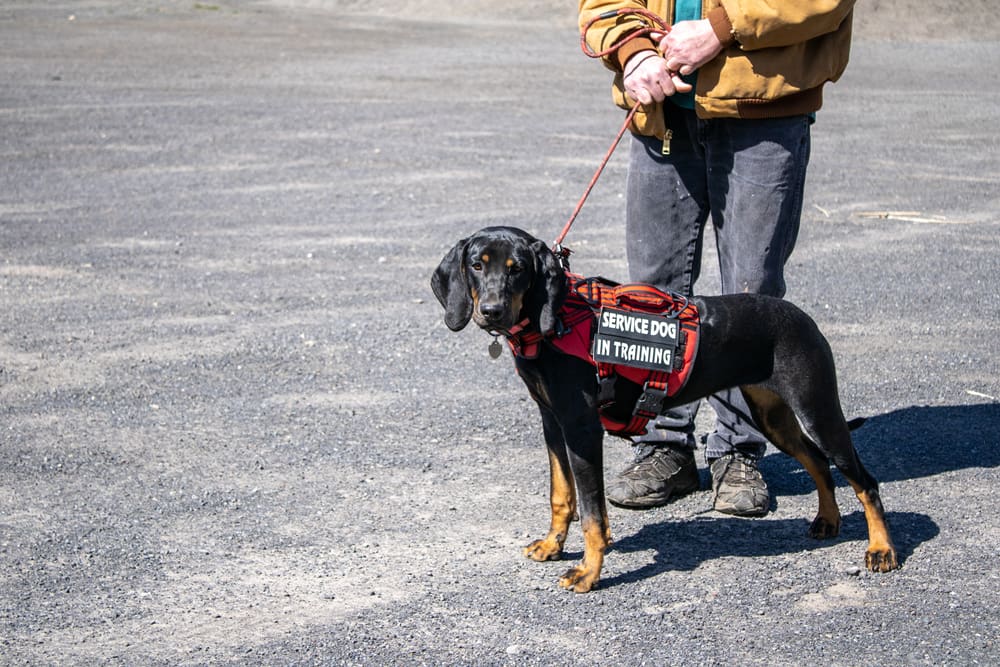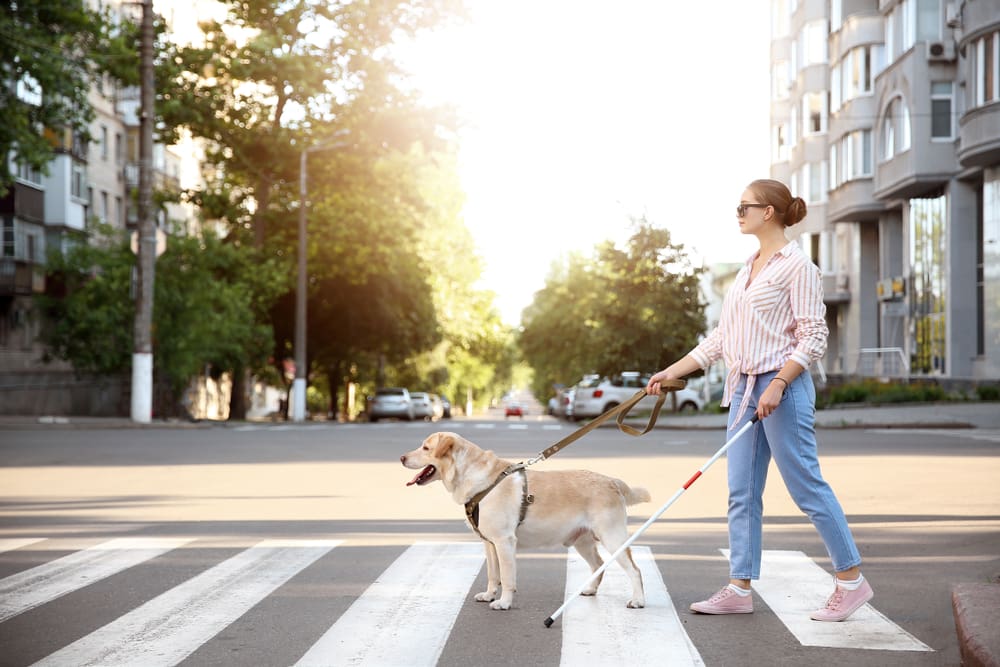Service dogs provide life-changing support for individuals with disabilities. With their assistance, individuals can lead more independent lives, engage in activities they may not have had the means to do before, and more easily attain their goals.
Service dogs can help with a range of conditions, including both psychological and physical disabilities. They are also entitled to certain legal protections under several federal and state laws.
If you feel a service dog would help you better manage your disability and its symptoms, you have a few options. You’ll either need to get in touch with a dedicated service dog training program, use a professional trainer, or train a service dog yourself.
We’ll discuss these training options in further detail below, but we’ll first cover what exactly a service dog is (and what kinds of disabilities qualify).
What Is a Service Dog?
A service dog, also known as an assistance dog, is a dog that has been specially trained to perform tasks that help mitigate symptoms of a disability. These working animals also have impeccable basic obedience skills and are able to stay alert in public settings without being reactive.
On top of performing trained tasks, service dogs can ease feelings of loneliness and isolation through their companionship. They can even provide a sense of security and help individuals feel more confident.
Any breed can become a service dog, though some breeds tend to fare better due to their high trainability and even-tempered demeanors. The most popular service dog breeds include poodles, Labrador retrievers, golden retrievers, and German shepherds.
Service dogs are protected under several laws, including the Americans with Disabilities Act (ADA) and the Fair Housing Act (FHA). They are granted public access rights, exemption from pet fees on flights, and reasonable accommodation in rented properties and the workplace.
Service Dogs vs Emotional Support Animals
Service dogs and emotional support animals (ESAs) are both animals that provide immeasurable support to individuals with disabilities. However, there is a clear distinction between the two.
While service dogs are trained to perform disability-related tasks, emotional support animals only provide therapeutic relief through their presence and companionship. Any animal can also become recognized as an ESA, regardless of species.
ESAs do receive some legal protections, like the right to live with their owners even in properties with no-pet policies, though they aren’t considered working dogs under the ADA and therefore aren’t granted as many rights as service dogs.
What Disabilities Qualify for a Service Dog?
Any individual with a physical, emotional, or mental disability can be eligible for a service dog, provided that they have received an official diagnosis through a licensed healthcare professional. They must also be able to show that their disability hinders at least one major life activity and that a service dog will help alleviate their symptoms.
Some disabilities that qualify for a service dog include:
- Depression
- Anxiety disorders
- Chronic pain
- Paralysis
- Arthritis
- Mobility issues
- Diabetes
- Personality and mood disorders (such as bipolar disorder)
- Post traumatic stress disorder (PTSD)
- Obsessive-compulsive disorders
- Autism
- Cerebral palsy
- Multiple sclerosis (MS)
- Sensory impairments (e.g. deafness, blindness)
What’s more, to qualify you must have the means to train and care for a dog, as well as provide them a safe, secure living environment.
What Tasks Does a Service Dog Perform?
Service dogs can be trained to perform a whole range of tasks that assist those with disabilities. For example, a service dog can help an individual with impaired vision navigate around obstacles, or alert a diabetic person to fluctuations in blood sugar levels.
Some of the most common tasks service dogs are trained to perform include deep pressure therapy (DPT), medication retrieval, and mobility assistance.
Deep Pressure Therapy
A service dog can be trained to apply their body weight and warm onto their handler on command (or when they detect signs of distress). Known as deep pressure therapy, the pressure applied has a soothing, calming effect that can help ease feelings of anxiety.
Deep pressure therapy can also serve as an effective grounding technique, with the physical sensation helping to bring the handler back to the present moment if they’re experiencing flashbacks, intrusive thoughts, or periods of disassociation.
Retrieve Medication
A service dog can be taught to retrieve medication when their handler is unable to do so themselves. They can also be taught to remind their handler to take their medication at specific times, minimizing the chances of late or missed dosages.
Mobility Assistance
A service dog can help those with mobility issues in a whole range of ways. They can be trained to provide balance support, elevate their handler’s legs, or help them navigate around obstacles. A service dog can even assist with position changes or pushing a wheelchair.
Service Animal Training Options


If you believe a service dog will help you better manage your disability and cope with its symptoms, there are a few ways to obtain one. You can either go through a service animal training program, use a professional service dog trainer, or train a service dog yourself.
Service Dog Training Programs
There are a number of organizations in the United States that provide fully-trained service dogs to those with disabilities. Many programs operate on a non-profit basis and donate these service dogs for free or at a low cost, while others are privately run.
Non-profit organizations usually have a wait time of up to five years. Private training programs come with lower wait times, making them a better option for those who need service animals quickly. However, they usually charge a hefty fee (upward of $50,000).
Using a service animal training program comes with many benefits. The dogs are fully vetted and undergo several assessments to determine their suitability for service work. Then, they’re carefully trained to flawlessly perform the disability-related tasks of their future handlers.
Service animal programs also carefully match dogs with handlers to ensure happy and successful long-term partnerships. Plus, they have the means to prepare dogs for a wide range of distractions, environments, and situations. So, you can trust a service program-trained dog to always be ready for you whenever you need their assistance.
You can use the Assistance Dogs International’s directory to find non-profit service dog organizations near you. Some organizations are tailored to specific disabilities, so it’s important to take your time to thoroughly research which ones are best for you and your needs.
Once you’ve narrowed it down to a few options, you’ll need to contact each program directly to learn more about their application process, waiting times, and eligibility criteria.
If you choose to go through a service dog training program, here’s what the general process would look like:
- Provide Evidence of Disability
You will need to get in touch with your healthcare professional and ask them to provide documentation that states your disability and need for a service animal.
- Submit Your Application
The application process can vary, but most service dog training programs will ask you to fill out an online form. This form contains several personal questions about your disability, needs, and living situation.
- Attend an Information Day
If your initial application is accepted, you’ll usually need to attend an information day, where the organization will explain more about the service dog training program. You can (and should) also ask the staff questions to determine whether the organization and the support they provide is the best fit for you.
- Further Assessment
If you’re still interested in the program after the information day, most organizations will require you to attend an individual assessment, usually at one of their training centers. They’ll ask you for further information about your disability, needs, and home life.
Most organizations will also conduct a home check to ensure your environment is suitable and safe for a dog.
- Join the Waiting List
If your application is approved, you’ll be added to the service dog training program’s waiting list. Wait times can vary, depending on the organization and your individual needs, but expect to wait up to five years (or one to three years on average).
- Attend Matching Visits
Once you’re near the top of the waiting list, the training organization will invite you to meet a service dog who they feel is a good match for your needs. During this visit, the program will assess your compatibility and give you plenty of time to bond with the pup.
- Finding Your Match
If it’s not a match, you’ll be put back on the waiting list until another potential match is found. If both you and the organization decide that the pup is a good fit, then the organization will move on to the next stage.
- The Training Process Begins
The program will begin training the animal to perform your required disability-related tasks (if they haven’t done so already). They may require an upfront deposit at this stage, with the exact price depending on the organization and whether you go for non-profit or private.
- Attend a Training Course
This course serves as a great opportunity to bond with your new pup and become familiar with their trained tasks. You will receive guidance from a professional service dog trainer throughout the course.
- Taking Your Service Dog Home
When the pup is ready — and you’ve attended all the necessary meetings and training courses — you’ll be able to take them home with you.
You’ll be provided plenty of support and guidance during this time to prepare you for their arrival. The organization will also usually visit you regularly, particularly within the first few months, to check how you’re getting along.
Professional Service Dog Trainer


Another option is to hire a professional service dog trainer. They have the expertise and experience to teach your pet the disability-related tasks you require and can help with other facets of training too, like basic obedience and impulse control.
A professional trainer is a great option for those who need a service dog urgently but can’t afford the fees of a private training program.
A professional trainer will still be fairly expensive, with most charging $11 to $23 per hour. However, it’s usually more affordable than a private program if you’re willing to contribute to the pup’s training in your own time too.
Using a professional service dog trainer also gives you more control over the training process, since you can meet the trainer regularly and discuss your needs and preferences.
Training a Service Dog Yourself
The ADA states that service dogs do not need to be professionally trained, meaning it’s possible to train a service dog yourself. Self-training is by far the most affordable option, and it allows you to bond closely with your service dog. However, it is incredibly time-consuming and requires a lot more commitment on your part.
That said, if you feel you would be able to train a service dog yourself, there are plenty of online resources that can help you with the process. From free training guides to dedicated service dog communities, you’ll always find answers to your questions.
We’ll briefly touch on what the self-training process involves to help you determine whether it’s a suitable route for you:
- Find a Suitable Service Dog Candidate
You can either adopt a dog who meets the criteria or assess a current pet for their eligibility. The best candidates are dogs who are calm, highly trainable, and confident around other people and animals. They must also be able to ignore distractions and feel comfortable in a range of environments.
- Socialization and Basic Obedience
Once you’ve found a suitable service dog candidate, you’ll need to start the training process. Begin by teaching them key basic obedience commands like “sit” and “stay,” and socialize them to different sounds, settings, strangers, animals, and situations.
- Public Access Skills
Your pup will also need to be taught how to behave in public. They must remain calm and under control at all times, and avoid defecating, barking loudly, or exhibiting other unwanted behavior in public spaces.
The animal must also be trained to ignore environmental distractions. As a guideline, follow the International Association of Assistance Dog Partners’ (IAADP) minimum training standards for public access.
- Teach Disability-Related Commands
Finally, you’ll need to teach your pup the disability-related task(s) you require. There are plenty of online, affordable training courses that can show you how to train your dog to perform tasks like deep pressure therapy and medication retrieval. Many non-profit service dog charities also provide free training resources.
Once your pup can reliably perform the disability-related tasks, they can be legally recognized as a service dog.
Which Service Dog Training Route Is Best for Me?


To summarize, we’ll provide a quick overview of the pros and cons of each service dog training option. This should give you a better understanding of which route is best for you.
| Service Dog Training Approach | Pros | Cons |
| Service animal training organization |
|
|
| Professional dog trainer |
|
|
| Training a service dog yourself |
|
|
Getting Your Service Dog (and Forever Companion)
Living with a disability can be challenging and extremely overwhelming, but remember that you don’t have to tackle the symptoms alone. A service dog can assist you by relieving such symptoms, and they’ll also provide you with companionship and affection.
Training a service dog can be a difficult process, but the time, effort, and commitment involved are definitely worth it! If you don’t have the means to train a service dog yourself, remember that you can instead seek assistance from a service dog training program or a professional trainer.
There are plenty of options, so make sure to consider our tips above and pick the route that’s right for you.




